
Île-d'Aix
Encyclopedia
Île-d'Aix is a commune
in the Charente-Maritime
department off the west coast of France
. It occupies the territory of small island
of Île d'Aix in the Atlantic
. It is a popular place for tourist day-trips during the summer months.
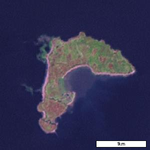 Île-d'Aix is located at the mouth of the Charente River
Île-d'Aix is located at the mouth of the Charente River
, between l'Ile d'Oléron and the coast of mainland France. The island is also close to Fort Boyard
.
 During the Roman period, it seems the island was connected to the continent at low tide. She finally took her current shape around 1500.
During the Roman period, it seems the island was connected to the continent at low tide. She finally took her current shape around 1500.
In 1067, Isembert de Châtelaillon
gave the island to the order of Cluny
. A small convent was established, which depended on St Martin in Ile de Re
.
At the end of the 12th century, France and England fought for the possession of the island. Until 1286, the island was located at the boundary between the French and the English "Saintonge", formed by the estuary of the Charente River
. During the Hundred years war, Aix became English for about 15 years.
In the 16th century, during the French Wars of Religion
, the island became Catholic
and then Protestant.
In 1665, nearby Rochefort
was established as a strategic harbour for the Kingdom, leading to the construction of many fortifications in the area. Vauban
built numerous fortifications on the island, which Ferry completed in 1704.
During the Seven Years' War
(1756–1763) the British captured the island in 1757 and destroyed its ramparts as part of the attempted Raid on Rochefort
, before withdrawing several weeks later. The island of Île-d'Aix was again captured by British forces in 1759 following the Battle of Quiberon Bay
, and occupied until the end of the war in 1763. The fortifications were then rebuilt by several French officers, including Pierre Choderlos de Laclos
, the author of Les Liaisons dangereuses
.
During the French revolution
, in 1794, the island was used as a prison for the suppression of religious opponents, in which hundreds of priests were left to die in moored prison-boats.
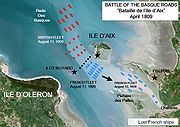 Napoleon famously visited the island in 1808 and gave directions to reinforce the fortifications. He ordered the construction of a house for the commander of the stronghold (today's "Musée Napoleon"), and the construction of Fort Liedot, named after a colonel killed in the Russian campaign.
Napoleon famously visited the island in 1808 and gave directions to reinforce the fortifications. He ordered the construction of a house for the commander of the stronghold (today's "Musée Napoleon"), and the construction of Fort Liedot, named after a colonel killed in the Russian campaign.
In 1809, the Battle of the Basque Roads
(French: Bataille de l'Île d'Aix) was a naval battle
off the island of Aix between the British Navy and the Atlantic Fleet of the French Navy
. On the night of 11 April 1809 Captain Thomas Cochrane
led a British fireship attack against a powerful squadron of French
ships anchored in the Basque Roads
. In the attack all but two of the French ships were driven ashore. The subsequent engagement lasted three days but failed to destroy the French fleet.
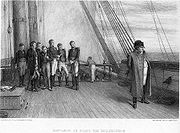 In 1815, from July 12 to 15, Napoleon also spent his last days in France at Ile d'Aix, after the defeat at Waterloo
In 1815, from July 12 to 15, Napoleon also spent his last days in France at Ile d'Aix, after the defeat at Waterloo
, in an attempt to force a Royal Navy
blockade to escape to the United States
. Realizing the impossibility to accomplish this plan, he wrote a letter to the British regent.
and finally surrendered to HMS Bellerophon
, which took him to Plymouth
before transferring him to Saint Helena
.
n independentist and future president Ben Bella was imprisoned there from 1956 to 1962, together with other FLN
militants such as Khider and Aït Ahmed.
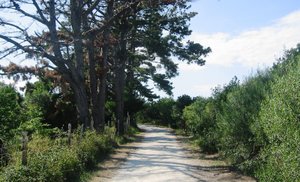
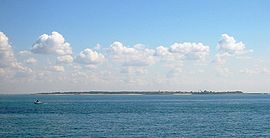 Access to the island is provided by a ferry
Access to the island is provided by a ferry
that leaves several times a day year round from Fouras
just east of the island, or from La Rochelle
, and Oléron
, during the summer months. Cars (except for service vehicles) are prohibited on the island, affording more tranquility. People move around on foot or by bicycle. Horse carriages are also available to circle the island.
Communes of France
The commune is the lowest level of administrative division in the French Republic. French communes are roughly equivalent to incorporated municipalities or villages in the United States or Gemeinden in Germany...
in the Charente-Maritime
Charente-Maritime
Charente-Maritime is a department on the west coast of France named after the Charente River.- History :Previously a part of Saintonge, Charente-Inférieure was one of the 83 original departments created during the French Revolution on 4 March 1790...
department off the west coast of France
France
The French Republic , The French Republic , The French Republic , (commonly known as France , is a unitary semi-presidential republic in Western Europe with several overseas territories and islands located on other continents and in the Indian, Pacific, and Atlantic oceans. Metropolitan France...
. It occupies the territory of small island
Island
An island or isle is any piece of sub-continental land that is surrounded by water. Very small islands such as emergent land features on atolls can be called islets, cays or keys. An island in a river or lake may be called an eyot , or holm...
of Île d'Aix in the Atlantic
Atlantic Ocean
The Atlantic Ocean is the second-largest of the world's oceanic divisions. With a total area of about , it covers approximately 20% of the Earth's surface and about 26% of its water surface area...
. It is a popular place for tourist day-trips during the summer months.
Location

Charente River
The Charente is a 381 km long river in southwestern France.Its source is in the Haute-Vienne département at Chéronnac, a small village near Rochechouart. It flows through the departments of Haute-Vienne, Charente, Vienne and Charente-Maritime...
, between l'Ile d'Oléron and the coast of mainland France. The island is also close to Fort Boyard
Fort Boyard
Fort Boyard is a fort located between the Île-d'Aix and the Île d'Oléron in the Pertuis d'Antioche straits, on the west coast of France. Though a fort on Boyard bank was suggested as early as the 17th century, it was not until the 1800s under Napoleon Bonaparte that work began.-Layout:Fort...
.
History

In 1067, Isembert de Châtelaillon
Isembert de Châtelaillon
Isembert de Châtelaillon, or Isembard de Castrum Allionis, also Isembert the Last, also spelled Isambert, was a French nobleman and the master of the city of Châtelaillon in Charente-Maritime, a territory which covered the area between the Sèvre river in the north and the Charente river in the...
gave the island to the order of Cluny
Cluny
Cluny or Clungy is a commune in the Saône-et-Loire department in the region of Bourgogne in eastern France. It is 20 km northwest of Mâcon.The town grew up around the Benedictine Cluny Abbey, founded by Duke William I of Aquitaine in 910...
. A small convent was established, which depended on St Martin in Ile de Re
Île de Ré
Île de Ré is an island off the west coast of France near La Rochelle, on the northern side of the Pertuis d'Antioche strait....
.
At the end of the 12th century, France and England fought for the possession of the island. Until 1286, the island was located at the boundary between the French and the English "Saintonge", formed by the estuary of the Charente River
Charente River
The Charente is a 381 km long river in southwestern France.Its source is in the Haute-Vienne département at Chéronnac, a small village near Rochechouart. It flows through the departments of Haute-Vienne, Charente, Vienne and Charente-Maritime...
. During the Hundred years war, Aix became English for about 15 years.
In the 16th century, during the French Wars of Religion
French Wars of Religion
The French Wars of Religion is the name given to a period of civil infighting and military operations, primarily fought between French Catholics and Protestants . The conflict involved the factional disputes between the aristocratic houses of France, such as the House of Bourbon and House of Guise...
, the island became Catholic
Catholic
The word catholic comes from the Greek phrase , meaning "on the whole," "according to the whole" or "in general", and is a combination of the Greek words meaning "about" and meaning "whole"...
and then Protestant.
In 1665, nearby Rochefort
Rochefort, Charente-Maritime
Rochefort is a commune in southwestern France, a port on the Charente estuary. It is a sub-prefecture of the Charente-Maritime department.-History:...
was established as a strategic harbour for the Kingdom, leading to the construction of many fortifications in the area. Vauban
Vauban
Sébastien Le Prestre, Seigneur de Vauban and later Marquis de Vauban , commonly referred to as Vauban, was a Marshal of France and the foremost military engineer of his age, famed for his skill in both designing fortifications and breaking through them...
built numerous fortifications on the island, which Ferry completed in 1704.
During the Seven Years' War
Seven Years' War
The Seven Years' War was a global military war between 1756 and 1763, involving most of the great powers of the time and affecting Europe, North America, Central America, the West African coast, India, and the Philippines...
(1756–1763) the British captured the island in 1757 and destroyed its ramparts as part of the attempted Raid on Rochefort
Raid on Rochefort
The Raid on Rochefort was a British amphibious attempt to capture the French Atlantic port of Rochefort in September 1757 during the Seven Years War...
, before withdrawing several weeks later. The island of Île-d'Aix was again captured by British forces in 1759 following the Battle of Quiberon Bay
Battle of Quiberon Bay
The naval Battle of Quiberon Bay took place on 20 November 1759 during the Seven Years' War in Quiberon Bay, off the coast of France near St. Nazaire...
, and occupied until the end of the war in 1763. The fortifications were then rebuilt by several French officers, including Pierre Choderlos de Laclos
Pierre Choderlos de Laclos
Pierre Ambroise François Choderlos de Laclos was a French novelist, official and army general, best known for writing the epistolary novel Les Liaisons dangereuses ....
, the author of Les Liaisons dangereuses
Les Liaisons dangereuses
Les Liaisons dangereuses is a French epistolary novel by Choderlos de Laclos, first published in four volumes by Durand Neveu from March 23, 1782....
.
During the French revolution
French Revolution
The French Revolution , sometimes distinguished as the 'Great French Revolution' , was a period of radical social and political upheaval in France and Europe. The absolute monarchy that had ruled France for centuries collapsed in three years...
, in 1794, the island was used as a prison for the suppression of religious opponents, in which hundreds of priests were left to die in moored prison-boats.
Napoleonic period

In 1809, the Battle of the Basque Roads
Battle of the Basque Roads
The Battle of the Basque Roads, also Battle of Aix Roads was a naval battle during the Napoleonic Wars off the Island of Aix...
(French: Bataille de l'Île d'Aix) was a naval battle
Naval battle
A naval battle is a battle fought using boats, ships or other waterborne vessels. Most naval battles have occurred at sea, but a few have taken place on lakes or rivers. The earliest recorded naval battle took place in 1210 BC near Cyprus...
off the island of Aix between the British Navy and the Atlantic Fleet of the French Navy
French Navy
The French Navy, officially the Marine nationale and often called La Royale is the maritime arm of the French military. It includes a full range of fighting vessels, from patrol boats to a nuclear powered aircraft carrier and 10 nuclear-powered submarines, four of which are capable of launching...
. On the night of 11 April 1809 Captain Thomas Cochrane
Thomas Cochrane, 10th Earl of Dundonald
Admiral Thomas Cochrane, 10th Earl of Dundonald, 1st Marquess of Maranhão, GCB, ODM , styled Lord Cochrane between 1778 and 1831, was a senior British naval flag officer and radical politician....
led a British fireship attack against a powerful squadron of French
First French Empire
The First French Empire , also known as the Greater French Empire or Napoleonic Empire, was the empire of Napoleon I of France...
ships anchored in the Basque Roads
Basque Roads
Basque Roads is a sheltered bay on the Biscay shore of the Charente-Maritime département of France, bounded by the Île d'Oléron to the west and the Île de Ré to the north...
. In the attack all but two of the French ships were driven ashore. The subsequent engagement lasted three days but failed to destroy the French fleet.

Battle of Waterloo
The Battle of Waterloo was fought on Sunday 18 June 1815 near Waterloo in present-day Belgium, then part of the United Kingdom of the Netherlands...
, in an attempt to force a Royal Navy
Royal Navy
The Royal Navy is the naval warfare service branch of the British Armed Forces. Founded in the 16th century, it is the oldest service branch and is known as the Senior Service...
blockade to escape to the United States
United States
The United States of America is a federal constitutional republic comprising fifty states and a federal district...
. Realizing the impossibility to accomplish this plan, he wrote a letter to the British regent.
and finally surrendered to HMS Bellerophon
HMS Bellerophon (1786)
The first HMS Bellerophon of the Royal Navy was a 74-gun third-rate ship of the line launched on 6 October 1786 at Frindsbury on the River Medway, near Chatham. She was built at the shipyard of Edward Greaves to the specifications of the Arrogant, designed by Sir Thomas Slade in 1758, the lead ship...
, which took him to Plymouth
Plymouth
Plymouth is a city and unitary authority area on the coast of Devon, England, about south-west of London. It is built between the mouths of the rivers Plym to the east and Tamar to the west, where they join Plymouth Sound...
before transferring him to Saint Helena
Saint Helena
Saint Helena , named after St Helena of Constantinople, is an island of volcanic origin in the South Atlantic Ocean. It is part of the British overseas territory of Saint Helena, Ascension and Tristan da Cunha which also includes Ascension Island and the islands of Tristan da Cunha...
.
Population
Sights
Located on the island is the large Fort Liédot which functioned as a military prison from the early 19th century to the 1960s. The AlgeriaAlgeria
Algeria , officially the People's Democratic Republic of Algeria , also formally referred to as the Democratic and Popular Republic of Algeria, is a country in the Maghreb region of Northwest Africa with Algiers as its capital.In terms of land area, it is the largest country in Africa and the Arab...
n independentist and future president Ben Bella was imprisoned there from 1956 to 1962, together with other FLN
National Liberation Front (Algeria)
The National Liberation Front is a socialist political party in Algeria. It was set up on November 1, 1954 as a merger of other smaller groups, to obtain independence for Algeria from France.- Anticolonial struggle :...
militants such as Khider and Aït Ahmed.
Transportation


Ferry
A ferry is a form of transportation, usually a boat, but sometimes a ship, used to carry primarily passengers, and sometimes vehicles and cargo as well, across a body of water. Most ferries operate on regular, frequent, return services...
that leaves several times a day year round from Fouras
Fouras
Fouras is a commune in the Charente-Maritime department in the Poitou-Charentes region in southwestern France. It lies 34 km south of La Rochelle.-Geography:Fouras is on a peninsula...
just east of the island, or from La Rochelle
La Rochelle
La Rochelle is a city in western France and a seaport on the Bay of Biscay, a part of the Atlantic Ocean. It is the capital of the Charente-Maritime department.The city is connected to the Île de Ré by a bridge completed on 19 May 1988...
, and Oléron
Oléron
Île d'Oléron is an island off the Atlantic coast of France , on the southern side of the Pertuis d'Antioche strait....
, during the summer months. Cars (except for service vehicles) are prohibited on the island, affording more tranquility. People move around on foot or by bicycle. Horse carriages are also available to circle the island.
External links
- Official Website
- Aerial view 1757 The attack of Island of Aix by the Royal Navy during the Seven Years' WarSeven Years' WarThe Seven Years' War was a global military war between 1756 and 1763, involving most of the great powers of the time and affecting Europe, North America, Central America, the West African coast, India, and the Philippines...

